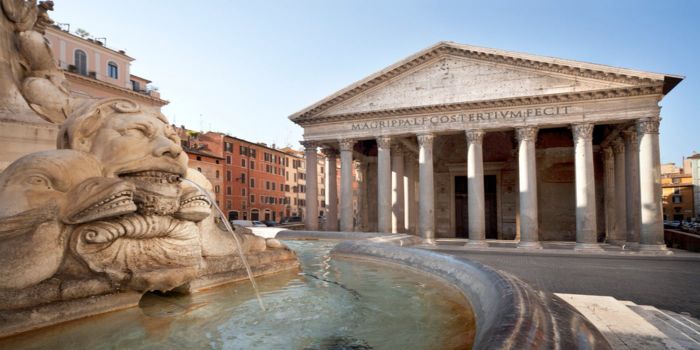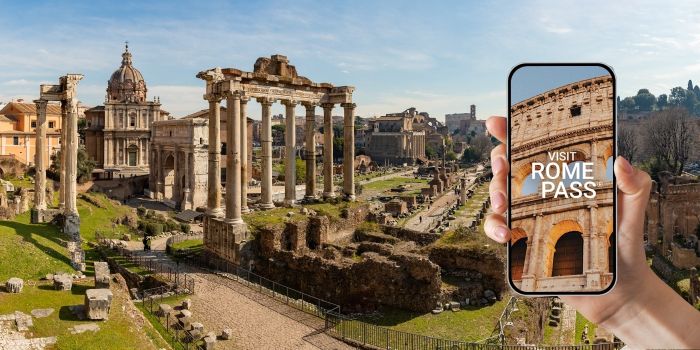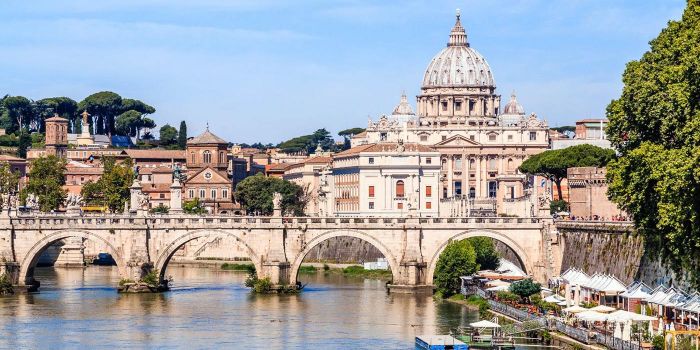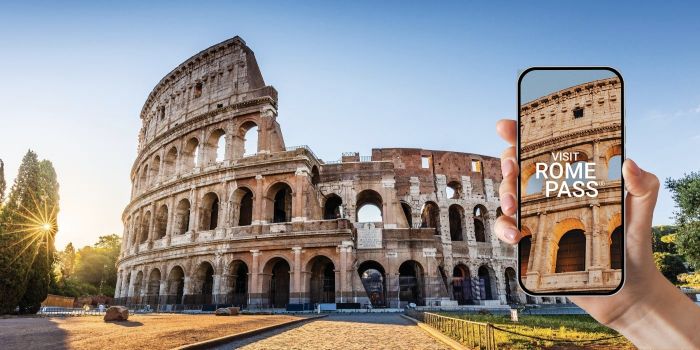Visiting the Pantheon: the iconic temple of ancient Rome
Pantheon: the tickets most chosen by travelers
The Pantheon: Ancient Place of Worship, Now an Iconic Monument of Rome
The Pantheon is one of Rome's most iconic monuments, symbolizing its ancient religiosity and serving as an architectural masterpiece thanks to its fascinating dome. Located in the Pigna district, in the heart of the historic center, this extraordinary temple was built in 27 BCE by Marcus Vipsanius Agrippa and derives its name from the ancient Greek “Pantheon,” meaning "temple of all gods". Originally dedicated to the goddess Cybele and all deities of the past, present, and future, the Pantheon has adapted to new purposes over the centuries. In the 7th century, it was consecrated as a Christian church, preserving it from neglect. Today, it is known as the Church of Santa Maria ad Martyres.
But, what does the Pantheon look like? To describe the Pantheon to someone who has never seen it, one cannot overlook its harmonious majesty. The Pantheon is circular, featuring a monumental concrete dome 43 meters wide. At the center of the dome is the oculus, a circular opening 7.5 meters in diameter, allowing natural light to enter and create a captivating and ever-changing play of light. The oculus not only illuminates and ventilates the building but also serves a symbolic purpose. In ancient times, it represented a window to the heavens, a connection between the earthly and the divine. Moreover, the oculus functioned as a sundial, with the light's path changing throughout the day and seasons, giving a sense of time. Visiting the Pantheon is a unique and impactful experience for both architecture and engineering enthusiasts as well as lovers of ancient history.
Discover all other experiences
Useful Information for Visiting the Pantheon
Pantheon: tips for your visit
How to get to the Pantheon
Located at Piazza della Rotonda in Rome's historic center, the Pantheon can be reached through various options:
On Foot:
If you are in the city center, the Pantheon is easily accessible on foot from many main attractions. It’s just a 5-minute walk from Piazza Navona and about 10 minutes from the Trevi Fountain.
By Metro:
The nearest metro stop is Barberini (Line A), about a 15-minute walk from the Pantheon. From there, head towards Via del Corso and follow the signs to the Pantheon.
By Bus:
Several buses stop nearby. You can take lines 30, 70, 81, 87, or 492 and get off at Senato or Corso/Minghetti stops, both just a few minutes' walk away.
By Taxi or Ridesharing:
Taxis are readily available in Rome's center. Simply ask the driver to take you to "Piazza della Rotonda" for direct access to the Pantheon.
Note that many areas in central Rome are pedestrian-only, so walking to the Pantheon is a great way to enjoy the city’s other attractions along the way.
The best experiences in Rome
Best attractions around Pantheon
all entrance tickets for the most popular Italian attractions
St.Peter's Basilica
RomeColosseum
RomeVatican Museum
RomeTrevi Fountain
RomeSistine Chapel
RomeSant'Angelo Castle
RomeTivoli Villas
RomeBorghese Gallery
RomeHow to visit the Pantheon in Rome: our guideline
Among the most beloved and popular symbols of Rome, the temple of the gods is an essential stop: here is how to visit to the Pantheon properly.
Read more
FAQs About Visiting the Pantheon
Can I book tickets in advance?
Yes, it is highly recommended to book tickets in advance, especially during high season. Tickets can be purchased online, with a "skip-the-line" option to avoid long waits.
Is the Pantheon accessible to disabled visitors?
Yes, the Pantheon is accessible for visitors with mobility issues. Ramps are available to access the building, but it’s advisable to contact in advance for specific support information.
Can I visit the Pantheon during religious services?
The Pantheon is also a place of worship, so during Mass or other religious ceremonies, entry may be restricted or unavailable. Check the service schedule before visiting.
What does the audio guide ticket include?
The audio guide ticket includes a self-guided tour explaining the history, architecture, and historical figures associated with the Pantheon. Audio guides are available in multiple languages.
Can I take a guided tour?
Yes, guided tours with experts are available, offering in-depth insights into the history and art of the Pantheon. Guided tours typically last about 30 minutes and can be booked in advance.
How much time should I dedicate to visiting the Pantheon?
A visit to the Pantheon usually takes about 30–45 minutes. For a more in-depth experience with an audio guide or tour, it may take up to an hour.
Is there a souvenir shop inside the Pantheon?
Yes, there are small shops inside the Pantheon where visitors can purchase souvenirs such as books, postcards, and religious items.
Everything you need to know before visiting the Pantheon
The Pantheon is located at Piazza della Rotonda, in the heart of Rome. Its strategic position makes it easily accessible on foot. Starting in 2023, entry to the main part of the Pantheon costs €5, reduced to €2 for youth aged 18–25, and is free for those under 18. Tickets can also include an audio guide, available in various price options and recommended to fully appreciate the visit.
To avoid long lines, it is advisable to book a tour with a "skip-the-line" option and add an audio guide or choose a guided tour. The Pantheon’s audio guide is particularly engaging, featuring actors portraying historical figures such as Emperor Hadrian, Pope Boniface IV, Raphael, and Queen Margherita of Savoy, accompanied by original music performed by the Orchestra of Teatro La Fenice. The recording lasts about 50 minutes and can be collected inside, while tickets can be picked up at the Basilica of San Lorenzo in Lucina, nearby.
The Pantheon is open daily from 9:00 AM to 7:00 PM, with the last entry at 6:30 PM.
A Brief History of the Pantheon
The Pantheon in Rome is one of the best-preserved monuments of antiquity. Built in 27 BCE by Marcus Vipsanius Agrippa, son-in-law of Emperor Augustus, it was a temple dedicated to all gods (hence the Greek name "Pantheon"). The original structure was destroyed by fire and later rebuilt by Emperor Hadrian between 118 and 125 CE, giving it its current form, including the iconic hemispherical dome—still one of the largest in the world.
In the 7th century, Pope Boniface IV converted the Pantheon into a Christian church, "Santa Maria ad Martyres," preserving it from destruction. During the Renaissance, it became the mausoleum of great figures like the artist Raphael.
Architecture of the Pantheon
The Pantheon is a true masterpiece of engineering and architecture. With its over two thousand years of history, it has remained intact over time, standing as a testament to classical architecture. The Pantheon represents a wonderful synthesis of the ideals of harmony typical of Greek architecture, enhanced by Roman engineering innovations. The Greek influence is clearly visible in the row of Corinthian columns, with fluted shafts and capitals decorated with acanthus leaves.
During its reconstruction in the 2nd century AD, under Emperor Hadrian's reign, Hellenistic elements were introduced in an eclectic style that blended Greek, Egyptian, and Near Eastern influences. Roman engineering innovation is most evident in the great dome, the largest of antiquity, which crowns the Pantheon. While Greek temples generally featured beam structures, the Romans perfected their techniques with arches, vaults, and concrete. The Pantheon’s dome is characterized by a coffered structure (recessed panels), which serves both an aesthetic and structural purpose. The dome, measuring approximately 43 meters in diameter, is constructed from concrete. At its center, the large oculus, with a diameter of 8.7 meters, allows natural light to enter, creating fascinating patterns of shadows. The interior hall, known as the Rotunda, is a circular room with marble floors. On the exterior, the grand portico with its columns supports the monumental central pediment. The entrance doors are made of bronze.
Curiosities About the Pantheon
Why is the Pantheon so significant?
The Pantheon is a unique testament to Roman culture, being the best-preserved monument of antiquity. Its brick dome is the largest in ancient history and has inspired countless structures worldwide.
What is inscribed on the Pantheon’s façade?
The inscription reads: “Marcus Agrippa, son of Lucius, consul for the third time, built this.” Emperor Hadrian included this during the reconstruction, honoring Agrippa, the original commissioner.
Does it rain inside the Pantheon?
Contrary to legend, rain does enter the Pantheon through the oculus. Drainage holes in the floor allow the water to flow out.
























Everything you need to know before visiting the Pantheon, the temple of Rome's ancient gods: skip-the-line tickets, guided tours, information.